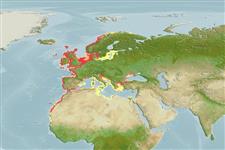Common names from other countries
Classification / Names / Names
ชื่อสามัญ | ชื่อพ้อง | Catalog of Fishes (gen., sp.) | ITIS | CoL | WoRMS
Environment: milieu / climate zone / depth range / distribution range
นิเวศวิทยา
; กร่อย; ระดับความลึก 0 - 5 m (Ref. 125442). Subtropical, preferred 10°C (Ref. 107945); 71°N - 14°N, 17°W - 33°E (Ref. 107077)
Eastern Atlantic, the Mediterranean and Black Sea: from Portugal to Egypt, north to Norway and Russia then south to Senegal, including Mediterranean and Black Sea. Occurrence in Iran, Persian Gulf is questionable.
Length at first maturity / ขนาด / น้ำหนัก / Age
Maturity: Lm ? range ? - ? cm Max length : 5.6 cm SHL เพศผู้/กระเทย; (Ref. 101424); common length : 3.5 cm SHL เพศผู้/กระเทย; (Ref. 437); อายุสูงสุดที่ได้รายงาน: 7 ปี (Ref. 2823)
The Burry Inlet Cockle Fishery of this species has been certified by the Marine Stewardship Council (http://www.msc.org/) as well-managed and sustainable (http://www.msc.org/html/content_486.htm). Found in shallow coastal and estuary areas (Ref. 95774); in the subtidal zone (Ref. 96507). Inhabits the seagrass meadows Zostera noltii and Cymodocea nodosa in sand flats (Ref. 106872). Also found on intertidal muddy sand flat. Infaunal (Ref. 106873). A deposit (Ref. 96459), and suspension feeder (Refs. 96498, 106872, 106873) that is a sessile-burrower (Ref. 96498). Feeds on microphytobenthos and particulate organic matter (Ref. 106873).
Life cycle and mating behavior
วัยเจริญพันธุ์ | การสืบพันธุ์ | การวางไข่ | เซลสืบพันธ์ของเพศเมีย(ไข่) | ความดกของไข่ | ตัวอ่อน
Members of the class Bivalvia are mostly gonochoric, some are protandric hermaphrodites. Life cycle: Embryos develop into free-swimming trocophore larvae, succeeded by the bivalve veliger, resembling a miniature clam.
Fischer, W., G. Bianchi and W.B. Scott (eds.). 1981. (Ref. 437)
IUCN Red List Status (Ref. 130435)
CITES status (Ref. 108899)
Not Evaluated
Not Evaluated
Human uses
การประมง: การค้า
FAO - การเพาะเลี้ยงสัตว์น้ำ: การผลิต; การประมง: landings, species profile | FishSource | ทะเลรอบๆเรา
เครื่องมือ
แหล่งที่มาจากอินเตอร์เน็ต
Estimates based on models
Preferred temperature
(Ref.
115969): 7.6 - 13.7, mean 10.4 (based on 742 cells).
ความสามารถในการกลับคืนสู่ปกติ
ความสูง, เวลาต่ำสุดที่จะทำให้ประชากรเพิ่มขึ้นเป็น 2 เท่าใช้เวลาน้อยกว่า 15 เดือน (K=0.46-0.66; tmax=7).
Prior r = 0.49, 95% CL = 0.33 - 0.74, Based on 1 data-limited stock assessment.
Vulnerability
Low vulnerability (24 of 100).
